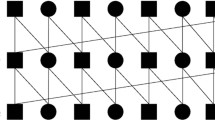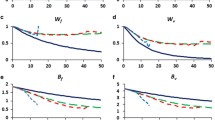Abstract
This work focuses on the consequences on thegenetic load and the risk of extinction when anendangered population is exposed to recurrentintroductions from a captive population whereselection is somewhat relaxed. Our findingssuggest that, although selection pressuresmight be reduced in captivity, which leads tohigher frequency of deleterious alleles innatural populations (Lynch and O'Hely 2001),such a population structure could have positiveeffects on population fitness when threeconditions are met: (i) the time length of thesupplementation program does not exceed areasonable time frame, e.g., 20 generations (ii)introduction of captive individuals is kept ata low level, i.e., one or two individuals pergeneration (iii) the size of the captivepopulation is reasonably large, e.g., more than20 individuals. The positive effect is due tothe fact that the supplementation programdelays the increase of homozygosity of thenatural population. When migration from thewild towards captivity is also allowed, thebenefits with regard to genetic load increasesignificantly even for larger numbers ofcaptive immigrants and a higher number ofgenerations. We also worked out a model withexplicit demographic considerations(fluctuating population sizes, captive migrantsincrease the size of the wild population),which shows that the probability of extinctiondecreases significantly with the number ofintroduced individuals when short-termsupplementation programs are applied (up totwenty generations). Furthermore, anappropriate genetic management of the captivepopulation, such as the equalization of familysizes, could enhance the positive effects ofsuch supplementation programs.
Similar content being viewed by others
References
Allendorf FW (1993) Delay of adaptation to captive breeding by equalizing family size. Conserv. Biol., 7, 416–419.
Arnold SJ (1995) Monitoring quantitative genetic variation and evolution in captive populations. In: Population Management for Survival and Recovery (eds. Ballou JD, Gilpin M, Foose TJ), pp. 295–317. Columbia University Press, New York.
Borlase SC, Loebel DA, Frankham R, Nurthen RK, Briscoe DA, Daggard GE (1993) Modeling problems in conservation genetics using captive Drosophilapopulations: Consequences of equalization of family sizes. Conserv. Biol., 7, 122–131.
Couvet D, Ronfort J (1994) Mutation load depending on variance in reproductive success and mating system. In: Conservation Genetics (eds. Loescheke V, Tomiuk J, Jain SK), pp. 55–68. Birkhauser, Basel.
Crow JF, Kimura M (1970) An Introduction to Population Genetics Theory. Harper & Row, New York.
Ebenhard T (1995) Conservation breeding as a tool for saving animal species from extinction. Trends Ecol. Evol., 11, 438–443.
Fernández J, Caballero A (2001a) A comparison of management strategies for conservation with regard to population fitness. Conserv. Genet., 2, 121–131.
Fernández J, Caballero A (2001b) Accumulation of deleterious mutations and equalization of parental contributions in the conservation of genetic resources. Heredity, 86, 480–488.
Frankham R, Manning H, Margan SH, Briscoe DA (2000) Does equalization of family sizes reduce genetic adaptation to captivity? Animal Conserv., 4, 357–363.
Franklin IR (1980) Evolutionary changes in small populations. In: Conservation Biology: An Evolutionary-ecological Perspective (eds. Soulé ME, Wilcox BA), pp. 135–149. Sinauer, Sunderland.
Gabriel W, Bürger R (1992) Survival of small populations under demographic stochasticity. Theor. Pop. Biol., 41, 44–71.
IUCN (1996) 1996 IUCN Red List of Endangered Animals. IUCN, Gland, Switzerland.
Keightley PD, Eyre-Walker A (1999) Terumi Mukai and the riddle of deleterious mutation rates. Genetics, 153, 515–523.
Lynch M, O'Hely M (2001) Captive breeding and the genetic fitness of natural populations. Conserv. Genet., 2, 363–378.
Lynch M, Blanchard J, Houle D, Kibota T, Schultz S, Vassilieva L, Willis J (1999) Perspective: Spontaneous deleterious mutation. Evolution, 53, 645–663.
Lynch M, Conery J, Bürger R (1995) Mutation accumulation and the extinction of small populations. Am. Nat., 146, 489–518.
Mills LS, Smouse PE (1994) Demographic consequences of inbreeding in remnant populations. Am. Nat., 144, 412–431.
Theodorou K, Couvet D (2002) Inbreeding depression and heterosis in a subdivided population; influence of the mating system. Genetical Research, 80, 107–116.
Theodorou K, Couvet D (2003) Familial versus mass selection in small populations. Genet. Sel. Evol., 35, 425–444.
Wang J, Ryman N (2001) Genetic effects of multiple generations of supportive breeding. Conserv. Biol., 15, 1619–1631.
Wang J, Hill WG, Charlesworth D, Charlesworth B (1999). Dynamics of inbreeding depression due to deleterious mutations in small populations: mutation parameters and inbreeding rate. Genet. Res., 74, 165–178.
Whitlock MC, Ingvarsson PK, Hatfield T (2000). Local drift load and the heterosis of interconnected populations. Heredity, 84, 452–457.
Author information
Authors and Affiliations
Rights and permissions
About this article
Cite this article
Theodorou, K., Couvet, D. Introduction of captive breeders to the wild: Harmful or beneficial?. Conservation Genetics 5, 1–12 (2004). https://doi.org/10.1023/B:COGE.0000014052.60145.f9
Issue Date:
DOI: https://doi.org/10.1023/B:COGE.0000014052.60145.f9




